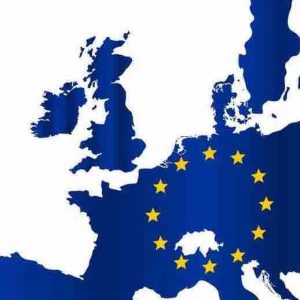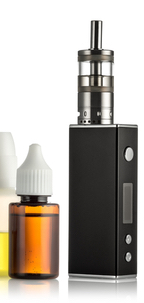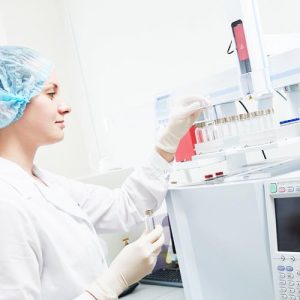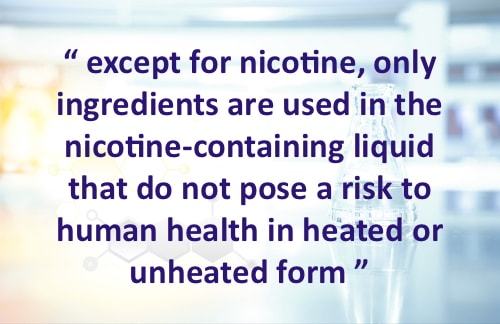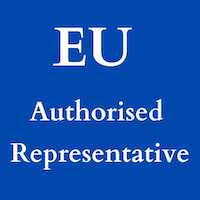TPD Regulations: What are they?
[vc_row][vc_column][vc_column_text]
What are the TPD Regulations?
New regulations on the sale and manufacture of e-cigarettes came into effect in May 2016. The TPD regulations include:
1) Rules on Product Characteristics:
- Max. 2ml tank size
- Max. 20mg/ml (2%) nicotine concentration
- Max. 10ml bottle size
- Child-resistance features
- Tamper evidence packaging
2) Notification Requirements
Manufacturers and producers are required to submit a notification to the authorities for any e-cigarettes and e-liquids they intend to market. The required information includes:
Administrative: details such as the contact details of the producer, description of product and declarations on production conformity.
Scientific data: including the classification of each ingredient according to CLP Regulation EC 1272/2008, all known toxicological studies and emissions testing data (TPD Test).
Sales information: the volume of sales, preference of consumer groups and mode of sales is to be reported.
E-cigarette regulation requires the submission of ingredients
3) Responsible Person
A company representative who is based in the EU should be identified in the notification. They will be the contact for the authorities or customers.
4) Advertising Restrictions
Under the new e-cigarette regulations, the following are prohibited:
- TV advertising and sponsorship
- TV product placement
- Radio advertising and sponsorship
- On-demand television advertising, sponsorship and product placement
- Newspapers, magazines and periodicals – except trade publications and third country publications,
- Internet display advertising, email and text message advertising – except trade publications and third country publications
But the rules allow e-cigarette advertising in the following media:
- Cinema
- Outdoor posters and on the sides of buses (not travelling outside the UK)
- Leaflets
- Direct hard copy mail
- Fax
Given the advertising restrictions, e-cigarette companies must work smarter to promote their products. Learn more about vape marketing strategies here. [/vc_column_text][vc_empty_space][vc_column_text css=”.vc_custom_1538951092577{border-top-width: 1px !important;border-right-width: 1px !important;border-bottom-width: 1px !important;border-left-width: 1px !important;padding-top: 20px !important;padding-right: 20px !important;padding-bottom: 20px !important;padding-left: 20px !important;background-color: rgba(78,252,246,0.47) !important;*background-color: rgb(78,252,246) !important;border-left-color: rgba(0,0,0,0.65) !important;border-left-style: solid !important;border-right-color: rgba(0,0,0,0.65) !important;border-right-style: solid !important;border-top-color: rgba(0,0,0,0.65) !important;border-top-style: solid !important;border-bottom-color: rgba(0,0,0,0.65) !important;border-bottom-style: solid !important;}”]
How can Medic Pro help?
We offer a wide range of services to help companies prepare for the TPD regulations, including:
- TPD testing: we help arrange e-cigarette testing in line with the TPD test requirements.
- Notifications: we can prepare and submit notifications for e-cigarettes and e-liquids on your behalf.
- Toxicological assessment: we advise on the toxicological requirements and can provide a toxicology expert
- TPD compliance: we will review your product to check it is TPD compliant
- Manufacturing standards: we provide an insight into the manufacturing standards before they are published
In the absence of guidance…
With e-cigarette regulation still in development, there are few official guidelines and no official standards. Where guidance is lacking, pharmaceutical regulatory guidelines can be used as a model. This is because e-cigarette regulation is based upon pharmaceutical regulation. Our knowledge and experience in pharmaceutical regulatory affairs combined with knowledge on the latest developments in e-cig regulation allows us to help manufacturers prepare early.[/vc_column_text][vc_empty_space height=”50px”][vc_btn title=”Get TPD Support” style=”flat” shape=”square” color=”danger” align=”center” link=”url:https%3A%2F%2Fmedicpro.london%2Fcontact-us%2F|||”][vc_empty_space height=”50px”][vc_column_text]
“Medic Pro really helped to alleviate the pressure caused by the TPD. We import products from China and getting the necessary assurances [as a result of the TPD] was sometimes difficult. Medic Pro supported us to make sure we were meeting our commitments. They also gave us confidence that whatever compliance issue might arise – with their support – it could be dealt with.
We’re very satisfied with the service and more than happy to recommend them.”
Fred (UK importer/retailer)[/vc_column_text][/vc_column][/vc_row][vc_row][vc_column][vc_empty_space height=”50px”][vc_separator][vc_empty_space height=”50px”][/vc_column][/vc_row][vc_row][vc_column][vc_column_text]
E-cigarette Regulation: Notes on TPD Article 20
An extract of the TPD Article 20 along with regulatory notes on paragraphs 1 and 2 is presented below.
“Electronic cigarettes
1. The Member States shall ensure that electronic cigarettes and refill containers are only placed on the market if they comply with this Directive and with all other relevant Union legislation.
Note: Other regulations that apply to e-cigarettes and e-liquids include Classification of Labelling and Packaging EC 1272/2008, Restriction of Hazardous Substances Directive 2011/65/EU and Waste Electrical and Electronic Equipment Directive 2012/19/EU.
Regulations other than the TPD apply to e-liquids & e-cigarettes
2. Manufacturers and importers of electronic cigarettes and refill containers shall submit a notification to the competent authorities of the Member States of any such products which they intend to place on the market. The notification shall be submitted in electronic form six months before the intended placing on the market. For electronic cigarettes and refill containers already placed on the market on 20 May 2016, the notification shall be submitted within six months of that date. A new notification shall be submitted for each substantial modification of the product.
A transition period between May 2016 and May 2017 allows producers to sell through existing stock. Conditions apply. This is only available in a few EU markets. As a general rule, produces should have complied with the Directive by May 2016.
The notification shall, depending on whether the product is an electronic cigarette or a refill container, contain the following information:
(a) the name and contact details of the manufacturer, a responsible legal or natural person within the Union, and, if applicable, the importer into the Union;
A non-EU producer is required to have a responsible person located within the EU. This person would be the first port of call for the regulatory authority and, possibly, customers.
(b) a list of all ingredients contained in, and emissions resulting from the use of, the product, by brand name and type, including quantities thereof;
e-cigarette testing conducted by an analytical laboratory is required on e-liquids and devices. Specialist equipment such as a ‘smoking machine’ is required along with knowledge and experience of testing e-cigarettes.
(c) toxicological data regarding the product’s ingredients and emissions, including when heated, referring in particular to their effects on the health of consumers when inhaled and taking into account, inter alia, any addictive effect;
A full toxicological risk assessment on an eLiquid is not required. Details of available toxicological studies is to be submitted as part of the TPD notification.
(d) information on the nicotine doses and uptake when consumed under normal or reasonably foreseeable conditions;
Full clinical trials demonstrating nicotine dosing and uptake are not required. Nicotine content in emissions should be demonstrated to be consistent (a part of the emissions test).
E-cigarette laws mean nicotine content must be consistent in emissions
(e) a description of the components of the product; including, where applicable, the opening and refill mechanism of the electronic cigarette or refill containers;
Technical standards on the refill mechanism apply. Refer to packaging and labelling.
(f) a description of the production process, including whether it involves series production, and a declaration that the production process ensures conformity with the requirements of this Article;
Manufacturing process should be presented in clearly laid out steps (in a way the assessor of the regulatory authority can easily understand).
(g) a declaration that the manufacturer and importer bear full responsibility for the quality and safety of the product, when placed on the market and used under normal or reasonably foreseeable conditions.
Non-EU producers: this may lead to a revision of the contractual terms between the manufacturer and importer in the EU.
Where Member States consider that the information submitted is incomplete, they shall be entitled to request the completion of the information concerned.
Non-payment of the notification fee will result in a delay to the notification process. In some cases, sub-standard descriptions of production process and testing methods may also cause delay.
Member States may charge manufacturers and importers proportionate fees for receiving, storing, handling and analysing the information submitted to them.”
Fees typically range from around £100 to £600 per notification (with an annual fee). Some Member States do not charge.
E-cigarette regulation: Notes on TPD Article 20.3
An extract of the TPD regulations Article 20 along with regulatory notes on paragraphs 3 is presented below.
“3. Member States shall ensure that:
(a) nicotine-containing liquid is only placed on the market in dedicated refill containers not exceeding a volume of 10 ml, in disposable electronic cigarettes or in single use cartridges and that the cartridges or tanks do not exceed a volume of 2 ml;
Note: Separately bought nicotine solution, which is commonly used in the mixing of ‘homemade’ DIY e-liquids and is often purchased in 7.2% concentration, is within scope of the TPD and its product restrictions including nicotine concentration (>2.0%) and container size (>10 ml).
(b) the nicotine-containing liquid does not contain nicotine in excess of 20 mg/ml;
See guidance on tolerance level for nicotine concentration (label claim vs. actual content).
E-cigarette regulations: Tolerance levels shall apply to nicotine strength e.g. +/- 5%
(c) the nicotine-containing liquid does not contain additives listed in Article 7(6);
The EU Manufacturing standards, currently in development, shall align with this provision. Additives in Article 7(6) include vitamins, caffeine, colourants and chemicals classed as carcinogens, mutagens or reprotoxins in unburnt form.
(d) only ingredients of high purity are used in the manufacture of the nicotine-containing liquid. Substances other than the ingredients referred to in point (b) of the second subparagraph of paragraph 2 of this Article are only present in the nicotine-containing liquid in trace levels, if such traces are technically unavoidable during manufacture;
‘Substances’ refers to heavy metals and other contaminants, the levels of which should be controlled in the finished product.
(e) except for nicotine, only ingredients are used in the nicotine-containing liquid that do not pose a risk to human health in heated or unheated form;
Permitted flavouring compounds may, in the future, be prohibited on new and emerging toxicological information.
New e-cigarette laws mean harmful ingredients are prohibited
(f) electronic cigarettes deliver the nicotine doses at consistent levels under normal conditions of use;
An indication of the emitted nicotine dose via laboratory testing (see TPD Testing) is required on packaging in some EU markets along with the nicotine label claim.
(g) electronic cigarettes and refill containers are child- and tamper-proof, are protected against breakage and leakage and have a mechanism that ensures refilling without leakage.”
Technical standards for refill mechanism and standards for child-resistant packaging for reclosable and non-reclosable packaging apply. Notably, devices should have tanks that are child-resistant.[/vc_column_text][/vc_column][/vc_row][vc_row][vc_column][vc_empty_space][vc_btn title=”Get TPD Support” style=”flat” shape=”square” color=”danger” align=”center” link=”url:https%3A%2F%2Fmedicpro.london%2Fcontact-us%2F|||”][/vc_column][/vc_row]
What We Do
We are a London-based regulatory affairs consultancy providing services to the e-cigarette, cosmetic, biocide, pharmaceutical and medical device industry. We help e-cigarette companies comply with the Tobacco Products Directive and pharmaceutical companies obtain and maintain medical product licences. We also offer UKAS accredited biocide and analytical testing services.

